SULPHRIC & ANODISING
Most commonly known as natural, clear or silver anodising, this is the common type of anodising, and the description covers a wide range of processes at different levels. This process differs from hard anodising in that the electrolyte temperature is higher and the current density employed is lower. The types of sulphuric acid are sub-divided into classes mainly determined by the field of application. All anodising processes are sealed unless the film is used as a primer for paint or adhesives.
ANODISING FOR PROTECTION
This is the most common form of anodic coating. Film thickness usually between three and thirty microns. The thinnest films stopping aluminium blackening the hands when handled, the thickest offering substantial corrosion resistance and electrical insulation without the loss of fatigue strength that can accompany hard anodising. The oxide layer is less dense than that of hard anodising and readily accepts a dye.

DECORATIVE ANODISING
As the name suggests the main purpose of this process is to provide a pleasing appearance to various components and covers a wide range of products. As the natural colour of anodising is silver or light grey, dyes may be used for colouring.
HARD ANODISING
The anodising process provides a method of electrolytically increasing the thickness of the naturally occurring oxide film on aluminium and its alloys, to give a coating which may be considered in many ways analogous to the case hardening of steel. It is distinguished from ‘decorative’ or ‘architectural’ anodising in that the process is operated in a manner, which gives optimum technical properties without regard to aesthetic effect; thus, the coatings may be grey or tinged with yellow or brown, according to the alloy and coating thickness.

Hard anodising produces darker coatings than the normal ‘decorative’ process, but the exact shade depends upon the coating thickness which for hard anodising is 50+ Microns and the type of alloy used will directly effect the thickness and shade of the component . We cannot, therefore, colour match except between components from the same batch of metal. Thinner hard anodised films generally 25 – 30 microns is often referred to as semi hard anodising .
It is advised that you consult us before machining any parts with very tight tolerances as there are many factors to consider when getting parts hard anodised.